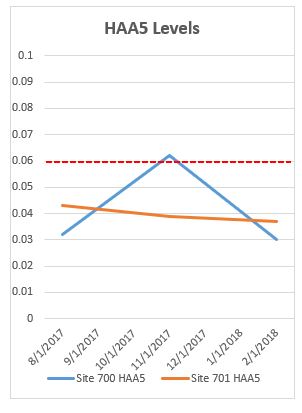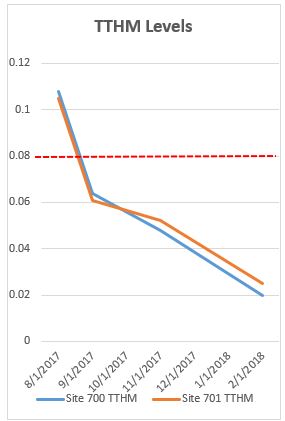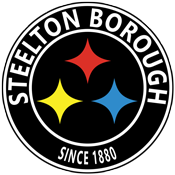Tier II DBP Violation – March 16th 2018
Most Recent Quarterly Samples Far Below Maximum Level: Contact Tank and DBP Improvements Working Effectively
Since September 2017, the chlorine contact tank and other improvements made to the Steelton water treatment plant and distribution system are effectively working to keep disinfection byproducts well below compliance levels. The most recent compliance tests taken on February 8, 2018 show our lowest DBP levels on record that are a fraction of the maximum allowed.


Below, you will see the most recent test results showing significant reductions in both TTHMs and HAA5s to levels well below the maximums. Since completion of the tank, nine of ten test results have been below the maximum level with the most recent tests producing our lowest levels recorded at both sites. All recent test results have shown minimal DBPs and a system that will be in full compliance once earlier results drop off of the yearly average.
Based on the positive results we are seeing, customers can expect one additional notification that the Steelton Authority has corrected the DBP issue. After this, future notices of violation are expected to cease.
The Authority thanks our customers who have been patient as capital improvements were made to correct the issue once and for all and allowed the Authority to stick to its plan to achieve compliance.
Included in this letter are charts that detail test results both before and after the chlorine contact tank became operational. The red line indicates the maximum contaminant level. As you will see, the tank and other improvements have led to a significant positive reduction in DBPs.
The Steelton Borough Authority will continue to stick with its improvement plan and closely monitor, report, and take measures to reduce DBPs.
Below we have defined the technical terms associated with fully understanding this notice and answers to frequently asked questions:
Important Terms:
Chlorine Contact Tank: A 260,000-gallon contact tank installed in September 2017 that allows for the chlorination of water post-filtration thus reducing the occurrence of disinfection byproducts.
Disinfection Byproducts (DBP): Chemicals found in drinking water when disinfectants such as chlorine react with naturally-occurring materials to form byproducts. Disinfectants, like chlorine, are used to kill microbes that can cause disease (e.g. gastrointestinal illness). Long-term exposures to consistently high levels of some disinfection byproducts have been associated with an increased risk of cancer.
Haloacetic Acids (HAA5) and Trihalomethanes (TTHMs): Disinfection byproducts that may, when consistently consumed in large quantities over a long period of time, slightly increase the risk for certain health impacts.
Locational Running Annual Average (LRAA): The average of the four most recent quarterly samples collected at specific sample sites. Each quarter, the LRAA is recalculated for purposes of determining compliance and the need for a public notice.
Maximum Contaminant Level (MCL): The maximum level of DBPs in parts per million that can exist in drinking water and remain compliant with U.S. Environmental Protection Agency (EPA) standards.
Source Water: Raw water that is drawn from the Susquehanna River and treated at the Steelton Water Treatment Plant. After treatment, the water is distributed through a network of water lines to Steelton residents.
Testing Locations: Two locations chosen in consultation with the Pennsylvania Department of Environmental Protection (DEP) that historically have the highest levels of DBPs. Test sites most likely represent the worst-case reading for the system at any given time.
Turbidity: The cloudiness of raw source water. Turbidity is indicative of the amount of matter in source water and is higher when the Susquehanna River is more turbulent (i.e. during rain storms and high river levels). High turbidity many times indicates more organic matter thus higher DBPs.
Why am I receiving another drinking water violation notice?
The enclosed non-emergency notice is required due to the LRAA for Haloacetic Acids (HAA5) at one testing site (Site 701) being higher than the maximum contaminant level. Both TTHMs and HAA5s tested significantly below the MCL at both sites this quarter. However, a high test result in August 2017 before the tank became operational has kept the average above the MCL.
Are HAA5 and TTHM violations unique to Steelton’s water system?
No. Many water systems in the country are dealing with TTHM and HAA5 violations due to more stringent EPA standards, changes in testing/reporting requirements, and aging water treatment infrastructure. Complying with these standards requires older water systems like Steelton’s to make long-term capital improvements. Steelton just completed its Chlorine Contact Tank Project and placed the tank in operation. As seen in the test results, the tank and other improvements are effectively reducing HAA5s and TTHMs well below maximum levels.
Why do disinfection byproducts like HAA5s and TTHMs occur in our water?
First, it is important to remember that the most recent test results for HAA5s and TTHMs have been well below compliance levels and continue to remain low.
Virtually all water systems have disinfection byproducts of some level due to the fact that chlorine remains the most widely used chemical for water disinfection in the world. According to the Center for Disease Control, “Chlorine revolutionized water purification, reduced the incidence of waterborne diseases across the western world,” and “chlorination and/or filtration of drinking water has been hailed as the major public health achievement of the 20th century.” It is necessary to chlorinate water to eliminate bacteria that causes immediate emergency health risks. No such emergency health risks are occurring due to Steelton’s continued treatment of water.
While chlorination kills harmful pathogens in water (the primary concern of water treatment facilities), the process of chlorine interacting with organic material in water creates what are known as disinfection byproducts, primarily Trihalomethanes and Haloacetic Acids.
The most recent Filter Plant Performance Evaluation study by DEP found that operational standards and procedures at the plant are satisfactory and significantly improved. The only remaining course to address the DBP issue is to upgrade water plant infrastructure. A major component—the chlorine contact tank—was completed in September 2017.
It is recognized that the removal of immediate pathogenic threats in water through chlorination takes first priority. Higher levels of disinfection byproducts are considered a Tier II non-acute violation (like the one enclosed). A lack of chlorination and the resulting microbial pathogens that would be present in water, represent a Tier I emergency violation.
Am I required to buy bottled water?
No. DEP and EPA clearly state that you do not need to change your source of water.
What if I have concerns about long term health risks associated with HAA5s and TTHMs?
Please consult your physician if you have any concerns about health risks associated with HAA5s and TTHMs.
What is the Water Authority doing to reduce/eliminate DBPs?
On September 8, 2017, the Chlorine Contact Tank was officially placed into operation. As discussed above, the tank and other improvements at the Water Filtration Plant and in the water system have effectively reduced DBPs to compliant levels and in most cases well below compliance levels. We anticipate this being the last notice of violation with a corrective notice to follow which informs consumers that we have corrected the DBP issue.
If you have any additional questions about disinfection byproducts or what we are doing, and have done, to ensure your drinking water is safe, please feel free to contact me at 717-939-9842 or Mark Handley at 717-939-0425 Ext. 5110. Douglas E. Brown, Borough Manager and Authority Secretary.
